Google Nexus 9: Preliminary Findings
by Joshua Ho on November 3, 2014 1:00 PM ESTCPU Performance
While there’s a great deal of ground to cover on the tablet as a whole, one of the most interesting aspects of the Nexus 9 is the SoC. While we’ve tested Tegra K1 before, we were looking at the more traditional Cortex A15 variant. The Denver variant (Tegra13x) is mostly similar to Tegra K1-32 (Tegra12x), but instead the CPU cores are a radically different design. In order to get an idea for how this translates into real world we can look at a few of our standard benchmarks in this area, although Google Octane couldn’t complete a full run. This build of Android clearly has AArch64 active, which means that we should be able to directly compare the Nexus 9 to the iPad Air 2 for performance.
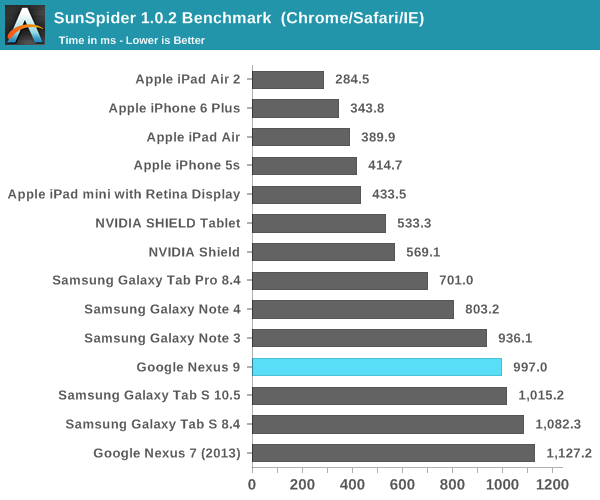
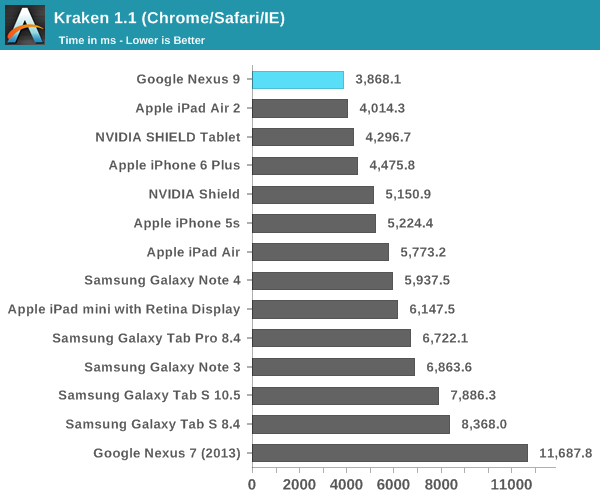

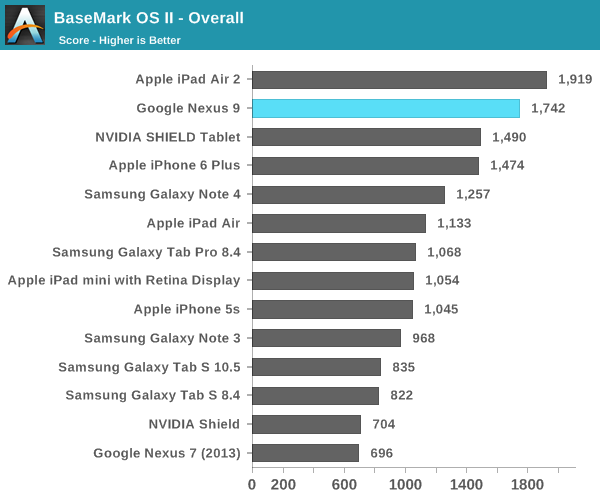
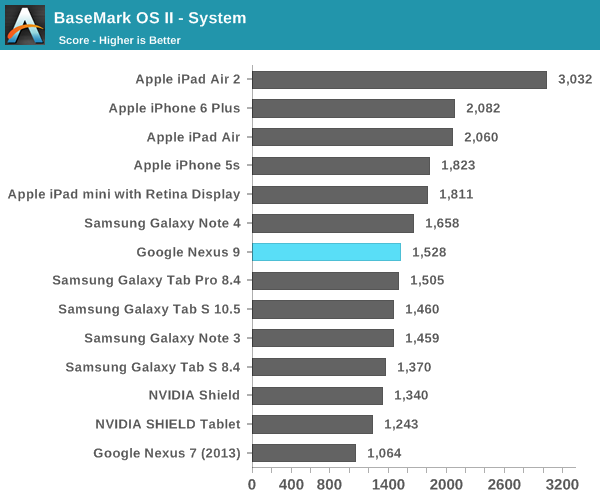
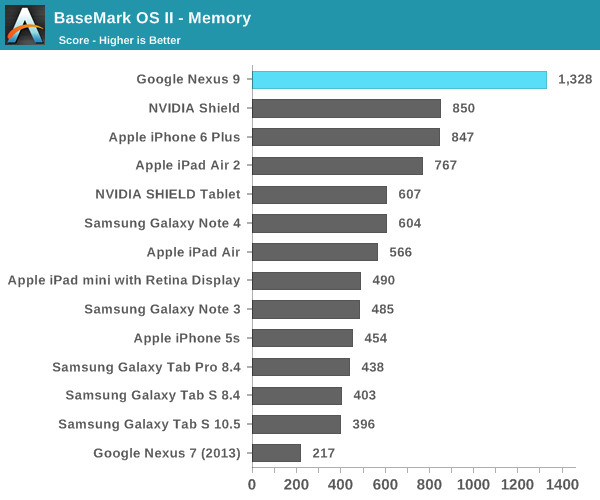
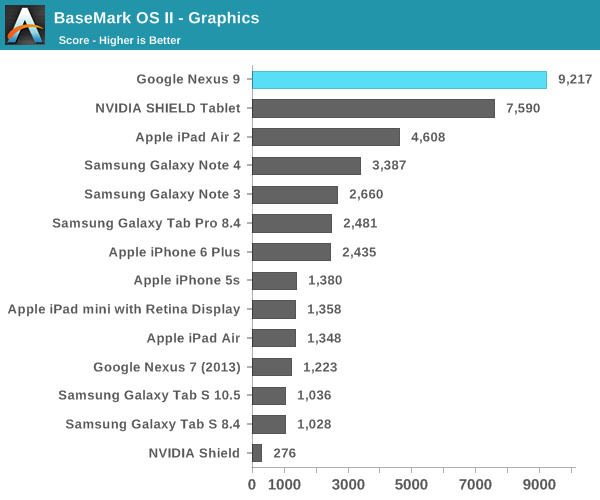
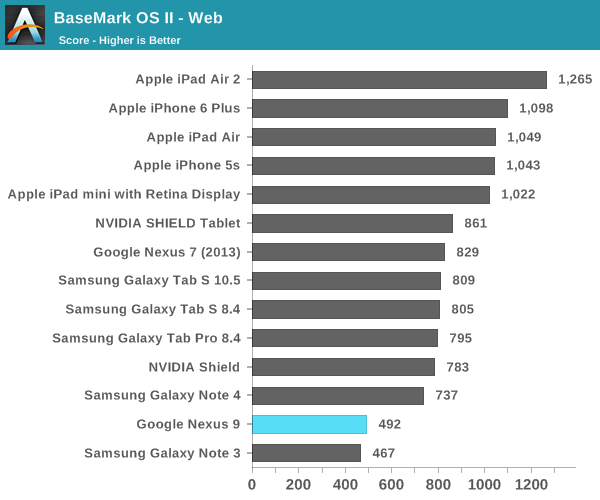
As one can see, at least at this stage in development the Nexus 9 can show some level of promise at times, but can be a bit disappointing in others. In SunSpider, Denver is generally even slower than Krait. However, in a benchmark like Kraken the Nexus 9 easily pulls ahead to take the top spot. In Basemark OS II the Nexus 9 does well overall but this seems to be due to its graphics performance/GPU performance and storage performance rather than CPU-bound tests like the system and web tests. It seems that when the code morphing systems works as expected, Denver can deliver significant amounts of performance. However, when such code morphing falls flat its true performance with a dual core, 2.3 GHz configuration is around that of a four Krait core CPU system at similar clock speeds. Once again, it's important to emphasize that this build is far from complete so performance should improve across the board with launch software. The fact that Tegra13x can approach A8X in CPU performance in some tests is definitely interesting to see.
Battery Life
While Denver's performance is a bit mixed, it's worth taking a look at battery life to see how Denver performs in these areas. As always, our battery life tests are all run with the display calibrated to 200 nits.
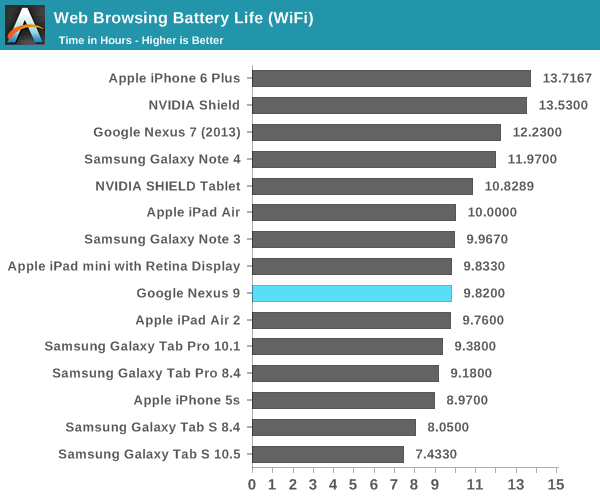
While an early build, it seems that the Nexus 9 is reasonably competitive in battery life but I'm not sure that these results are perfectly accurate. At any rate, efficiency at this stage seems to be par for the course, which should bode well for shipping software. This is a mostly display-bound test though, so we'll look at Basemark OS II to get a better idea for compute-bound battery life.
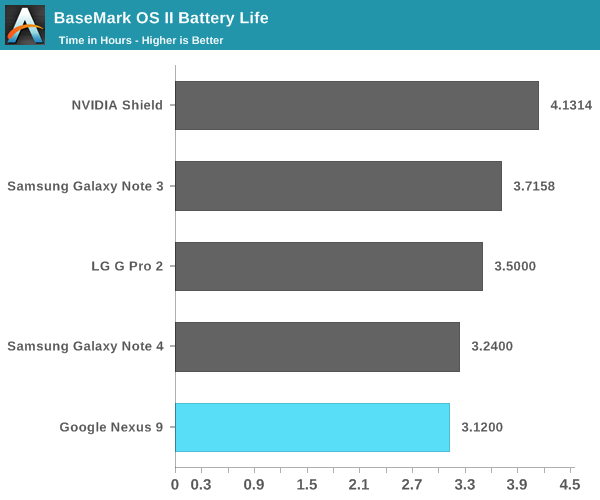

As one can see, while the battery life of the Nexus 9 ends up on the bottom for phablets and tablets, the overall performance during the test is quite high. We're working on a better comparison for the final review, but this should give a good idea of what to expect in general.










146 Comments
View All Comments
Ppietra - Monday, November 3, 2014 - link
Since the screen area difference is significantly larger than the battery size difference and both tablets give the same battery life, one can hypothesize that the A8X is more energy efficient than the Tegra k1.kron123456789 - Monday, November 3, 2014 - link
It's no surprise since A8X is 20nm and Tegra K1 is 28nm.chizow - Tuesday, November 4, 2014 - link
Again, can't make any such assumptions based on screen size alone, given early reviews show the Nexus 9 screen is brighter. Apple could've certainly put in a bigger battery or at the very least left the same size as the iPad Air 1, but I guess they wanted to trim weight and cut costs above all else.ams23 - Monday, November 3, 2014 - link
Nexus 9 has higher single-threaded CPU performance than iPad air 2 in Geekbench 3, and has higher performance in Kraken too (and possibly some other tests such as Octane). It depends on the workload and where the CPU can take advantage of dynamic code optimization.testbug00 - Tuesday, November 4, 2014 - link
based on some broken down geekbench single core, the Nvidia chip has about the same IPC in integer (~2800/2.2 Divided by ~1800/1.4 == ~99%) but, it has a huge deficit in FP (~1200/2.2 divided by ~1700/1.4) of only about 45%.Numbers ran in 32 bit for K1 as the 64b Android version that supports the K1 appears to not be functioning as it should. NVidia's numbers should improve a bit, probably to 100-115% of Int and 50-65% of Floating Point.
(The output is Tegra K1 Denver core having 99% Integer and 45% based on multiple-core scores PER CORE of Apple's tri-core A8 chip (~5200/2300 used for Tegra, ~5100/4900 used for tri-core A8)
Ratman6161 - Monday, November 3, 2014 - link
Also don't forget it's Android 5 so besides being an early build of the tablet, the OS may not be final either.Leosch - Tuesday, November 4, 2014 - link
I am pretty sure that the author is referencing the build of the software whenever he reminds us that this is not a final build. The hardware probebly is final, but the software is still on a testing build. Each compilation of a software packet givesLeosch - Tuesday, November 4, 2014 - link
... Sorry hit submit by accident. So I was saying:Each compilation gives you a build which is usually given a build number. In Android you can check your exact build number in the about phone menu in the last menu entry. I bet you can di the same in iOS
testbug00 - Tuesday, November 4, 2014 - link
looking at some numbers broken down in other places, the Denver CPU appears to be about the same IPC with integer code (~99.5% in the only numbers I have seen), and, about 69.1% of the IPC in Floating point code.That is per core. Also, I would say that the GPU in the K1 is faster than Apple's as Nvidia's top bin is 951Mhz according to Nvidia. Apple's is likely lower =] (the performance as a given clockspeed should be equal)
chizow - Monday, November 3, 2014 - link
Very impressive performance from Nvidia's Denver K1, their 1st 64-bit effort basically ties Apple's 2nd-gen 64-bit SoC without even the benefit of 20nm. Expecting big things from Erista next year with 20nm and Maxwell GPU.Overall this device I think missed on the lack of expandable storage and low entry level 16GB storage. Personally I think it is priced too close to iPad to do well, but we shall see. If they went with 32GB or even expandable storage I think it would have been a compelling alternative on the higher-end of tablet market.